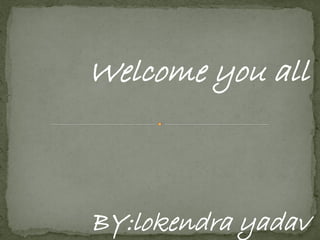
cochlear implant
- 1. Welcome you all BY:lokendra yadav
- 2. Cochlear implant A REVOLUTION IN The world of implant & hearing
- 3. cochlear
- 5. WHAT IS cochlear implant? ?
- 6. Volta: 18th century Djourno and Eyries: 1950 & 1957(head) House, Doyle, Simmons(six channel implant) 1972 Single-channel implant 1984 FDA approval 1990’s Beyond
- 7. A cochlear implant is an electronic device that allows many people with hearing loss to hear better. Unlike hearing aids, which amplify sound, cochlear implants bypass the damaged inner ear and send sound directly to the brain. Many recipients can reconnect with loved ones, contribute their talents at work, and chat comfortably in restaurants.
- 8. Cochlear implant Cochlear implant Engg. Medical Approach Approach
- 10. Components of Cochlear Implant
- 12. Single vs. Multiple channels Audio example of how a cochlear implant sounds with varying number of channels Monopolar vs. Bipolar Speech processing strategies Spectral peak (Nucleus) Continuous interleaved sampling (Med-El, Nucleus, Clarion) Advanced combined encoder (Nucleus) Simultaneous analog strategy (Clarion)
- 13. Basal coochlea Cochlear stimulation Apical cochlea Firing rate responses (color High frequencies Low frequencies coded) evoked by various Monopolar electrode cochlear-implant stimuli in the auditory cortex (guinea pig). Vertical axis = cortical place • top = caudo-medial • bottom = rostro-lateral Bipolar electrode Horizontal axis = time relative to stimulus onset Blue Yellow Red Low FR high FR (where “FR” = firing rate in action potentials/second) Tripolar electrode = FR weighted centroid of activity
- 14. Strategy Signal Stimulation Channels Rate Device Representation per channel CA Bandpassed Analog 4 Continuous Ineraid Waveforms Waveform CA Bandpassed Analog 8 13,000 Clarion1.0 Waveforms samples/sec CIS Envelope signals Pulsatile 8 833 pps Clarion1.0 CIS Envelope signals Pulsatile 8 1,515 pps Med-El F0/F2 Second formant, Pulsatile 1 F0 or Nucleus Voicing features random rate F0/F1/F2 First and second Pulsatile 2 F0 or Nucleus formant, random rate Voicing features
- 15. Simulation of cochlear implant……….
- 16. Cochlear-implant simulation Waveform of Original Sound 4 Simulated waveform x 10 8 2 6 1.5 4 1 Amplitude Amplitude 2 0.5 0 TextEnd 0 TextEnd -2 -4 -0.5 -6 -1 0 0.5 1 1.5 2 2.5 3 3.5 4 4.5 5 0 0.5 1 1.5 2 2.5 3 3.5 4 4.5 Time (sec) Time (sec) Spectrogram of Original Sound Spectrogram of simulated waveform 8000 8000 6000 6000 Frequency Frequency 4000 4000 TextEnd TextEnd 2000 2000 0 0 0 0.5 1 1.5 2 2.5 3 3.5 4 4.5 0 0.5 1 1.5 2 2.5 3 3.5 4 4.5 Time Time From Lokendra:_maulana azad medical college best 6 of 16 channels, 250 Hz pulserate, 16 kHz sampling H/U filterbank
- 17. General specification of cochlear implant device: Length of electrode array:25mm 2 Gnd electrode No of channels: 20 Electrode impedence:2K General features Surgical features Electrode array features Stimulation features
- 18. MEDICAL APPROACH
- 19. Adults 18 years old and older (no limitation by age) Bilateral severe-to-profound sensorineural hearing loss (70 dB hearing loss or greater with little or no benefit from hearing aids for 6 months) Psychologically suitable No anatomic contraindications Medically not contraindicated
- 20. R C.I.
- 21. Pre surgical requirement: Check the impedance of ear it should not be more CT findings Check BP No anatomical disorders in ear No psychological complain history
- 23. Surgical steps: Step 1: provide anesthesia to patient before 10 min (subjected) Step 2 : marking of area where incision would be given by methyl blue Step3: surgeon should initiate the process mastoidtomy, posterior tympanotomy by giving surface incision(temporal fasica graft) by using surgical blade or electric cut. Now temporal bone dissection : use drill bit of 1mm at 18000 to 20000 rpm not above .some time 3mm drill bit is also used. Facial nerve preservation is crucial part of the surgery
- 24. 1st Landmark incus stapes Incision in round window insertion of electrode
- 25. Cochlear receiver setting Bed arrangement Screw arrangement
- 29. Complication rate only 5% Wound infection/breakdown Yu, et al showed good response to Abx, I&D Facial nerve injury/stimulation, CSF leak, Meningitis CDC recommendations Vertigo (Steenerson reported 75%) Device failure—re-implantation usually successful Avoid MRI
- 30. Necessary part of implantation Different focus depends on patient’s previous experience with sound Goal is to enable children to be able to learn passively from the environment Program addresses receptive as well as expressive language skills Multidisciplinary, dedicated group necessary
- 31. Partial implants with hearing aid Those with residual low-frequency hearing Intraoperative mapping Bilateral implantation One vs. two speech processors Implantation for asymmetric SNHL “Softip” array Minimally invasive implantation
